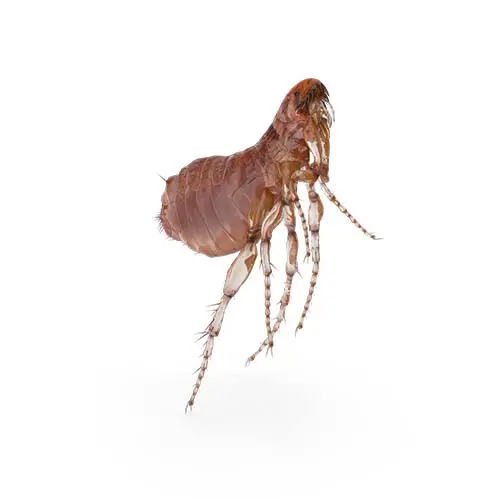The Season of Blooms and Bugging Fleas & Ticks
As we bid farewell to the colder days and welcome the vibrant spring season, we also brace ourselves for the increased activity of fleas and ticks. These pests are more than just a nuisance; they pose significant health risks for both pets and humans and are especially active in areas like Brighton, Firestone, and Arvada. Here, we’ll dive into effective identification, understanding the risks, and implementing thorough prevention methods to manage these pests efficiently.
Get a quote within minutes.1
Identifying Fleas and Ticks
Accurate identification is crucial in effectively tackling the problem:
- Fleas: These tiny insects are about an eighth of an inch long, appearing dark brown or black. Notorious for their jumping abilities, fleas can leap distances over one hundred times their body length. You might spot them as dark, quickly moving specks on your pet’s body, or notice the symptoms of their bites, such as excessive scratching, red patches on the skin, and hair loss.
- Ticks: Larger than fleas, ticks attach firmly to their hosts. They can vary in color and are initially about the size of a sesame seed. After feeding, they swell considerably, making them easier to spot. They prefer warm, moist areas of the body such as the groin, armpits, and scalp in humans, and around the ears and under the collars in pets.

Identify your foe: Close-up image of a flea jumping in Colorado.
Understanding the Risks
Both fleas and ticks are vectors for diseases, which can have serious implications:
- Fleas can transmit several diseases like the plague and murine typhus to humans, and are responsible for transmitting parasites like tapeworms to pets. Severe flea infestations can cause anemia, particularly dangerous in young or frail animals.
- Ticks are notorious carriers of Lyme disease
, which can cause severe joint pain, chronic fatigue, and neurological problems if untreated. Other diseases like anaplasmosis and babesiosis are also concerns in Colorado, making tick prevention even more crucial.
AN OBEX technician hard at work along the Colorado front range – expert flea and tick yard treatment.
Proactive Prevention Strategies
Effective prevention involves multiple strategies to ensure both immediate and long-term protection:
- Regular Pet Care: Incorporate regular checks and grooming into your pet care routine. After walks or playtime outdoors, thoroughly check your pets for ticks and fleas. Regular baths and the use of flea combs can help catch these pests early.
- Veterinary-Approved Preventatives: Engage with your vet to find the most effective flea and tick preventatives. These might include oral medications, spot-on treatments, or impregnated collars designed specifically for your pets’ needs and lifestyle.
- Professional Pest Control Services: Starting services like OBEX to treat your property. We are experts that can apply specialized treatments to your yard and the perimeter of your home, focusing on areas where pests are likely to breed. Our targeted approach helps ensure that your environment remains hostile to fleas and ticks.
- Environmental Management: Keep your yard tidy by mowing the lawn regularly, trimming bushes, and removing leaf litter. This reduces the habitats fleas and ticks thrive in. Also, consider creating barriers with gravel or wood chips to deter ticks from crossing into recreational areas of your yard.
- Personal Protection: When enjoying outdoor activities, wear protective clothing and consider using DEET or permethrin-based repellents on both skin and clothing to prevent tick bites. Light-colored clothing can help you spot ticks before they attach.
- Awareness and Education: Stay informed about the peak flea and tick seasons and recognize the early signs of infestation or disease both in humans and pets. Prompt action and consultation with healthcare providers can prevent serious health issues.
Embracing spring in Colorado should be a delightful experience, free from the worries of pests like fleas and ticks. By taking comprehensive and informed steps towards prevention, you can enjoy the season to its fullest, ensuring safety and health for your family and furry friends. Let’s make the most of our beautiful Colorado outdoors, safely and smartly.
1 During regular business hours (Monday – Friday, from 9 am to 5 pm), an OBEX representative and/or sales agent will contact you via call, text, email, and/or combination of the like, for the sale of pest control services. You agree that standard text messages and/or data rates may apply, and promotional/sale messaging can be stopped at any time by replying STOP, or unsubscribing at the bottom of emails. Claim of a reply “within minutes” is average response time during operation hours, and is not guaranteed.
Four+℠, Six+℠ and Six Pro℠: Twelve-month (12) agreement required. Early cancel fee may apply. All OBEX 365℠ plans: Spot treatment re-services requests may require waiting period, due to local, state and/or federal regulatory laws of pesticide applications or other routing conflicts. At its sole discretion, OBEX may limit the amount of free applications a customer may receive, and does not guarantee a specific timeframe requested by the customer may be available. Active pest issue must be occurring at the time of request, and visit requires someone over 18 to be present for the entire treatment.
* Service does not include the control or prevention of wood infesting organisms such as termites, powder post beetles, wood borers, carpenter ants, carpenter bees, wood wasps, or wood decay fungus. OBEX will treat for wasp nests on homes; however, we do not guarantee for flying insects. See Pest Control Service Agreement for additional information and limitations.




